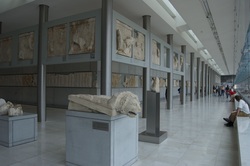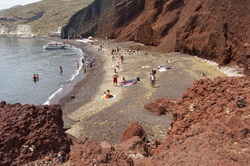
On Sunday, Professor Christiano and I took the slow boat from Santorini to Athens. We left at 7 a.m. and arrived at the port in Athens (Pireaus) at 3:30 p.m. That gave us time for one more museum run. We choose the Acropolis Museum, which we had to speed-walk through on our first day in Athens.
The Acropolis Museum is new and wonderful. It is a world-class museum that tells the story of the Acropolis and its main feature, the Parthenon. In so doing, it also tells the story of Athens and of Greece writ large.
You begin by walking over glass floors showing an archeology dig to set the tone. The artifacts are smartly displayed. They begin with the social story of everyday Athenians and their marriage customs, and then move to the Acropolis and the Parthenon. At the top is a re-creation of the Parthenon itself, with its elaborate sculptures mirroring their locations on the building visible through the glass walls.
On the walls are the few actual marbles that remain, along with white replicas of what are in the British Museum, courtesy of Lord Elgin in the early 1800s. The museum was clearly built to convince the British Museum that Greece could make a nice home for the Parthenon marbles.
I'm convinced. The Brits should give their marbles back to the Greeks.
The argument is if the British Museum does so, then it should have to return great art to the Egyptians and the Italians and the French and so on. But that's not true. The Parthenon is the only building of its kind in the world. So many Egyptian artifacts exist all over the world that they could never all be collected and returned, and shouldn't be. The Parthenon is different.
I spoke last night with the nice ice cream man I made friends with two weeks ago. He said he is waiting for the British Museum to return the marbles.
I hope he will be able to see the museum in his lifetime.

 RSS Feed
RSS Feed